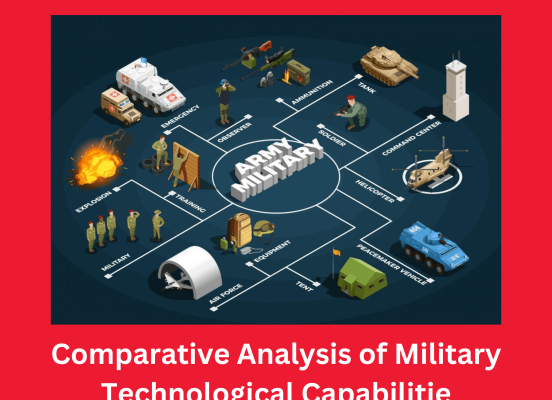
A Comparative Analysis of Military Technological Capabilitie
- By admin --
- Friday, 08 Mar, 2024
Introduction:
In an era defined by rapid technological advancements, military forces around the world continually strive to enhance their capabilities in weaponry, communication systems, and surveillance technology. This comparative analysis aims to examine the technological prowess of various military forces, considering factors such as innovation, investment, and strategic priorities.
Technological Innovations in Weaponry:
Weaponry constitutes a cornerstone of military power projection, and advancements in this domain can significantly influence battlefield outcomes. The United States Armed Forces stand at the forefront of technological innovation in weaponry, boasting a vast array of cutting-edge systems such as stealth aircraft (e.g., F-35 Lightning II), precision-guided munitions, and unmanned aerial vehicles (UAVs). These capabilities enable the U.S. military to conduct precise and lethal operations across diverse theaters of operation. Additionally, countries like Russia and China have made substantial strides in developing hypersonic weapons, challenging traditional notions of deterrence and strategic stability. Moreover, emerging technologies such as directed energy weapons and autonomous systems promise to revolutionize future warfare, with nations worldwide investing in research and development to maintain a competitive edge.
Communication Systems:
Effective communication is paramount for coordinating military operations and ensuring situational awareness on the battlefield. The United States possesses a sophisticated network-centric warfare capability, leveraging advanced communication systems such as satellite communications, secure radio networks, and data-sharing platforms. These systems enable seamless integration of disparate forces and facilitate real-time information exchange, enhancing decision-making and operational effectiveness. Similarly, NATO member states benefit from interoperable communication standards, enabling multinational cooperation and coalition operations. In contrast, countries with limited resources may face challenges in establishing robust communication infrastructures, potentially impeding their ability to coordinate complex military maneuvers.
Surveillance Technology:
Surveillance technology plays a pivotal role in gathering intelligence, monitoring adversary activities, and enhancing situational awareness. The United States leads the way in this domain, leveraging a comprehensive suite of surveillance assets, including satellites, unmanned aerial vehicles (UAVs), and reconnaissance aircraft. These platforms provide persistent surveillance capabilities, enabling timely detection of threats and facilitating precision targeting in various operational scenarios. Moreover, advancements in sensor technology, such as synthetic aperture radar (SAR) and electro-optical/infrared (EO/IR) sensors, enhance the resolution and accuracy of surveillance data, further enhancing the effectiveness of military operations. Other technologically advanced nations, such as Israel and Russia, have also developed sophisticated surveillance capabilities tailored to their strategic requirements, encompassing both terrestrial and maritime domains.
Integration and Interoperability:
Achieving seamless integration and interoperability among disparate technological systems poses a significant challenge for military forces worldwide. The United States and its allies invest considerable resources in developing standardized protocols and interfaces to facilitate interoperability across joint and coalition operations. Initiatives such as the NATO Interoperability Standards and the Joint All Domain Command and Control (JADC2) framework seek to harmonize communication protocols and data sharing mechanisms, enabling seamless integration of diverse platforms and sensors. However, interoperability remains a complex issue, particularly in multinational contexts where divergent technical specifications and operational procedures may hinder effective collaboration.
Cyber Resilience and Information Warfare:
In an increasingly digitized battlefield, cyber resilience and information warfare capabilities are critical for safeguarding military networks and countering adversary cyber threats. The United States maintains formidable cyber capabilities, encompassing offensive cyber operations, defensive cyber measures, and intelligence gathering activities. Organizations like the U.S. Cyber Command and the National Security Agency (NSA) play a pivotal role in conducting cyber operations and securing critical infrastructure against cyber attacks. Moreover, the integration of artificial intelligence (AI) and machine learning algorithms enhances the efficacy of cyber defense mechanisms, enabling proactive threat detection and rapid response capabilities. However, the proliferation of cyber threats poses significant challenges for military forces worldwide, necessitating constant vigilance and investment in cyber resilience measures.
Conclusion:
Conclusively, the technology capacity of armies globally indicate an active trend feature by invention, financing, and strategic rivalry among nations. Although there are countries with United States at forefront among others showing how advanced they are in technology, some nations are trying to catch up by investing domestically towards targeted domains while engaging in research and development locally. However, to bring into unity.





